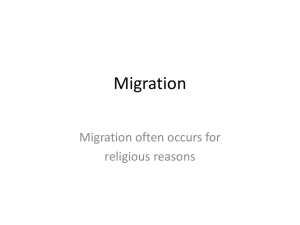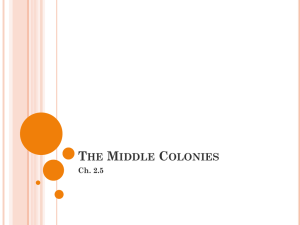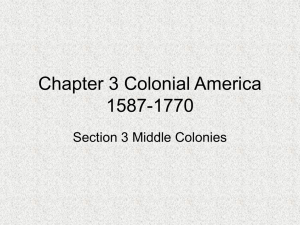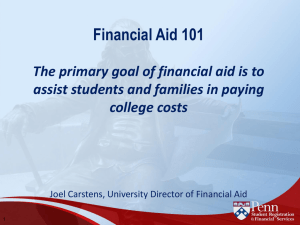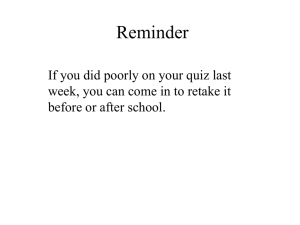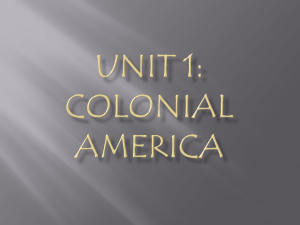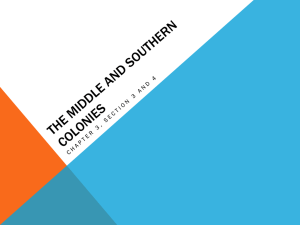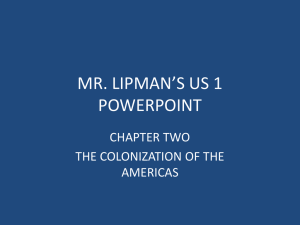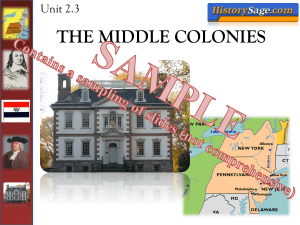William Penn - Digital Chalkboard
advertisement
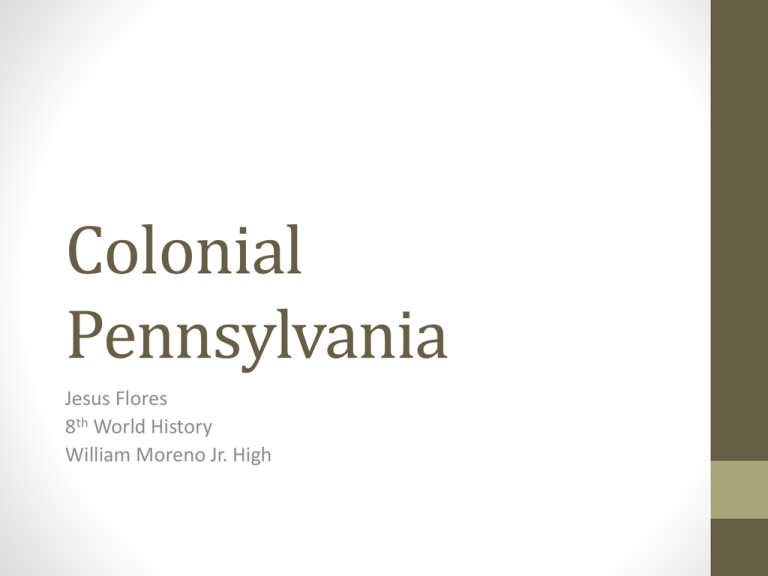
Colonial Pennsylvania Jesus Flores 8th World History William Moreno Jr. High Standard • 5.4.1 Understand the influence of location and physical setting on the founding of the original 13 colonies, and identify on a map the locations of the colonies and of the American Indian nations already inhabiting these areas. Learning Objective • Students will describe the primary reasons for the founding and the migration to the colony of Pennsylvania by creating a brochure to attract colonists to Pennsylvania. What is Pennsylvania? William Penn founded a colony that would allow the Quakers and other religious groups to practice their religion freely without religious persecution. Pennsylvania would become a diverse colony that consisted of many ethnic and religious groups and had friendly relations with the Native Americans. Content Vocabulary and Key People • Quakers: A Protestant group that had been persecuted or treated harshly because of their religious beliefs, in England. • William Penn: wealthy English Quaker, who would founded the colony of Pennsylvania. Restate-Apply-Justify • Choral the description of the colony of Pennsylvania? • Who were the Quakers? • Who was William Penn? William Penn • In 1680, William Penn, a Quaker, received the land in payment for a debt that King Charles II, owed William Penn’s father. • He was granted a royal charter on March 4, 1861 • The land given to William Penn would be called Pennsylvania, or “Penn’s Wood”. • It extended inland from the Delaware River. • It was as large as England • Origins of Name • Penn: Penn’s surname • Sylvania: “forest land” City of Philadelphia • In 1862, William Penn sails to America to supervise the building of Philadelphia. • “The city of brotherly love” • Greek translation • Philos: “love” • Adelphos: “brother” William Penn’s primary reason for founding Pennsylvania • William Penn had a desire to protect himself and others Quakers from religious persecution. • In England, Quakers were religiously persecuted. • William Penn saw Pennsylvania as a “Holy experiment”. • He believed that the Quakers could practice the ideas of toleration and equality. • William Penn wanted in his colony to have the freedom of worship and religion which would be granted to all citizens. Restate-Apply-Justify • Restate: Think-Pair-Share William Penn’s founding of his colony. • Who gave William Penn the land as settlement for a owed debt? • A. King Charles II • B. English Queen Henrietta Maria • C. King James I • What would be the name of the William’s Penn land? • A. Massachusetts • B. Rhode Island • C. Pennsylvania • What was the primary reason for people’s migration to Pennsylvania? • A. Free Land • B. Religious freedom • C. Representation Diversity • William Penn was hoping to establish a colony of many languages and customs. • Penn advertised his new colony and by 1863 he had more than 3,000 settlers. • • • • • English Welsh Irish Dutch German • Other religious groups would also arrive in Pennsylvania. • French Huguenots, Amish, Lutherans, and German Catholics. • William Penn also granted the colonist the right to elect representatives to the legislative assembly. Restate-Apply-Justify • Restate: Think-Pair-Share the Pennsylvania’s diverse colony True or False • 1. The English were the only Europeans to settle in Pennsylvania. • 2. Pennsylvania consisted of many religious group not just Quakers. • 3. Pennsylvania had an elected representative assembly. Native American Relations • William Penn had good relations with the Native Americans that were settled in his land. • William Penn believed that the land belonged to the Native Americans and that the Native Americans should be paid for their land. Restate-Apply-Justify • Restate: Think-Pair-Share with your partner Native America relation in Pennsylvania. • True or False • 1. William Penn had hostile relations with the Native Americans that were on his land. • 2. William Penn believed that the Native Americans should be paid for the land that the new settlers took. Closure • Objective: Students will describe the primary reasons for the founding and the migration to the colony of Pennsylvania. Brochure Front Flap • • • • • Title Cover Name of colony Colony shape picture Introductory Name Class & Period Brochure Inside Left Flap • Information • Demographics • Colony facts • Founder • Famous people • Economy Brochure Inside Right Flap • Persuasion for moving to Pennsylvania Colony • Religious Freedom • Diversity • Native American Relations Back Flap • Sources Cited • Where to find more information Rubric COLONY BROCHURE RUBRIC CATEGORY Historical Content Accuracy 4 3 2 1 All facts in the brochure are accurate and upto-date. Content relates to the state. 99-90% of the facts in the brochure are accurate. 89-80% of the facts in the brochure are accurate. A few inaccuracies evident. Fewer than 80% of the facts in the brochure are accurate. Content is not focused on the state. BROCHURE SECTIONS Required FRONT FLAP Organization of Ideas and Content Grammar and Spelling Each section in the brochure has a title cover, inside flaps, and ending flap. All required sections are included. Brochure is completely filled. Almost all sections of the brochure are present. Brochure utilizes space well. Most sections of the brochure are present. Space has some gaps. Less than half of the sections of the brochure are present. Space is not used wisely or well organized. Gaping holes are evident. -Title Cover -Name of Colony -Colony Shape Pic -Introductory Slogan -Student Name -Class & Period -Date There are no There are 1-2 grammatical or grammatical spelling mistakes. and/or spelling mistakes. There are some grammatical and/or spelling mistakes. There are several grammatical and/or spelling mistakes. INSIDE LEFT FLAP -Information -Demographics -Colony Facts -Economy Graphics/Pictures Graphics go well Graphics go well Graphics go well Graphics do not go Sources Attractiveness & Presentation Editing and Proofreading with the text and there is a good mix of text and graphics. 1+ graphics per section. with the text, but there are so many that they distract from the text. (too many) with the text, but there are too few and the brochure seems "textheavy". (too few) with the accompanying text or appear to be randomly chosen. (little to no graphics) Careful and accurate records are kept to document the source of 95100% of the facts and graphics in the brochure. (5+ sources are used and cited) Careful and accurate records are kept to document the source of 94-85% of the facts and graphics in the brochure. (At least 5 sources are cited) Careful and accurate records are kept to document the source of 84-75% of the facts and graphics in the brochure. (3 sources used and cited correctly.) Sources are not documented accurately or are not kept on many facts and graphics. (Less than 3 sources used or cited correctly.) The brochure has exceptionally attractive formatting and well-organized information. The brochure has The brochure has attractive well-organized formatting and information. well-organized information. The brochure's formatting and organization of material are confusing to the reader. Documented evidence of 4 editors (2 adults and 2 students other than the author) Documented editing and proofing by 1 adult and 1 student. No documentation of outside or independent editing/proofreading. Grade Interpretation Option: INSIDE RIGHT FLAP -Religious Freedom -Diversity -Native American Relations BACK FLAP A = 25+ pts Documentation of 1 person other than the author who edits and proofs the brochure. B = 19-24 pts -Sources Cited -Where to find more information * Optional -Little Known Facts -Unique Products C= 14-18 pts D= 7-13 pts -Laws & Rules -Cultural Nuances -Famous People -Must-sees or Musthaves -Quotations & -Other F = 0-6 pts
